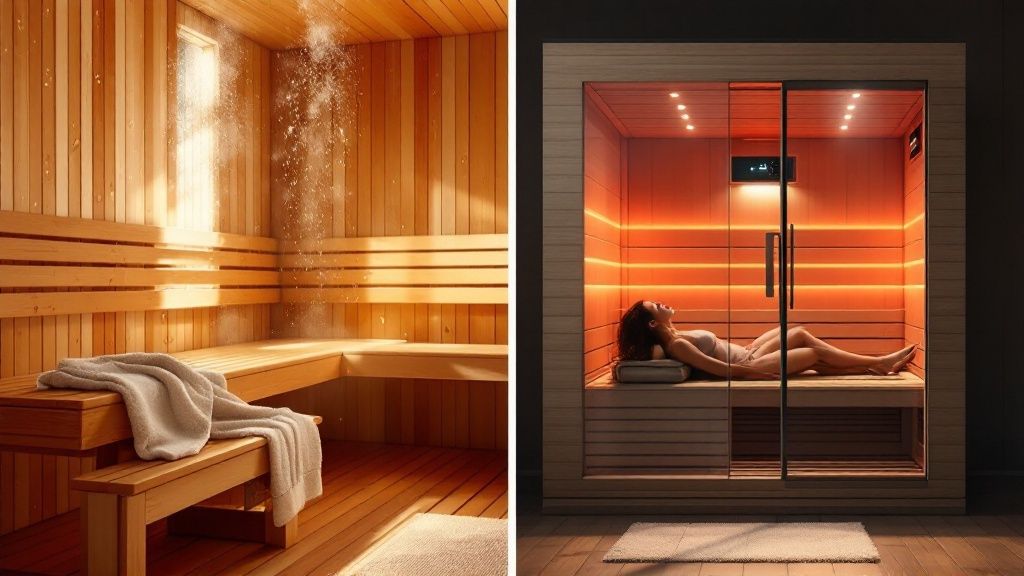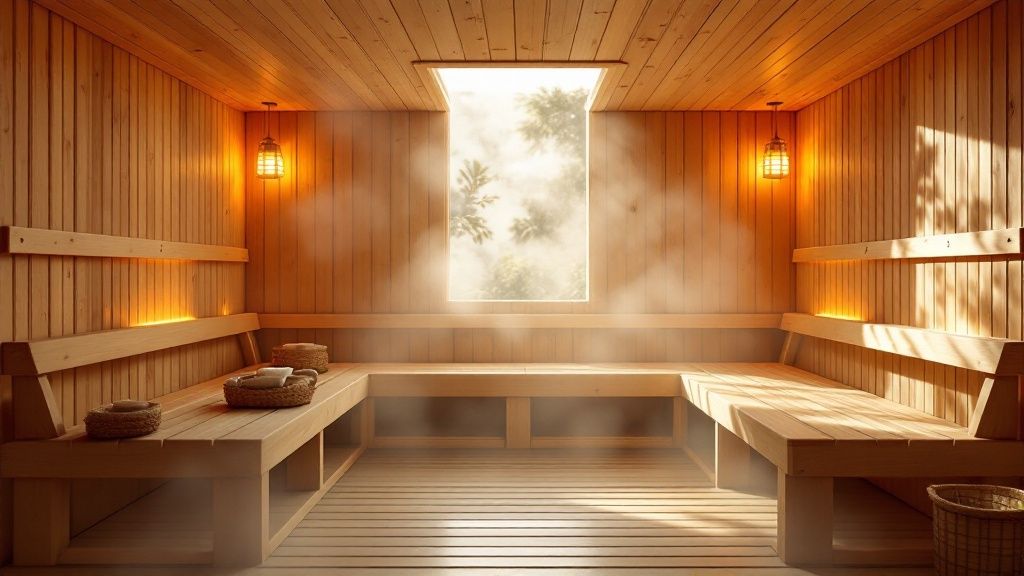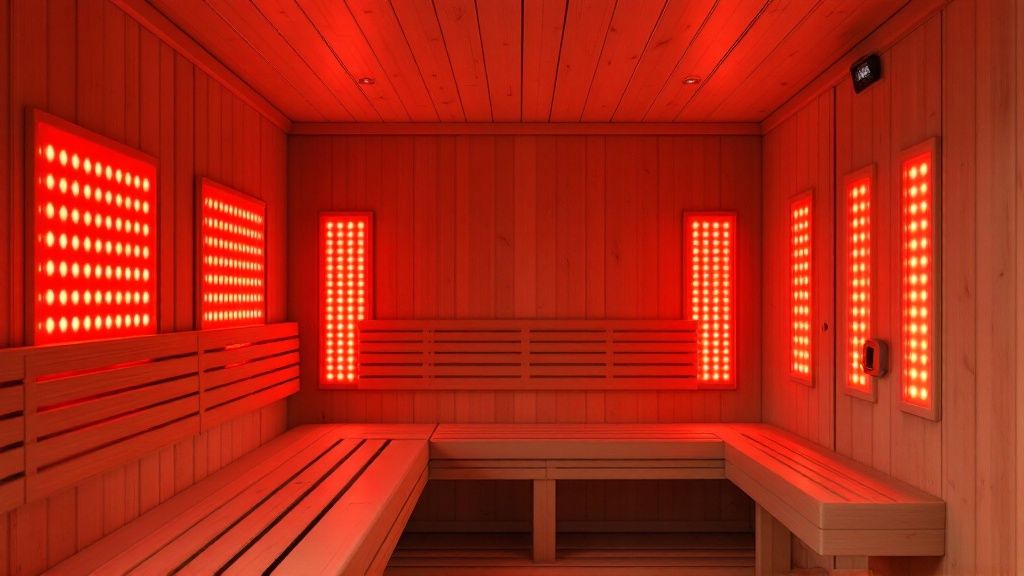
Steam vs Infrared Sauna A Definitive Guide
When you're trying to decide between a steam sauna and an infrared sauna, the biggest difference comes down to one simple thing: how they create heat.
A traditional steam sauna works by heating the air around you to a high temperature, creating that classic, steamy, and intensely hot room we all picture. An infrared sauna, on the other hand, uses light waves to heat your body directly, bypassing the air and working at much lower, more comfortable temperatures.
So, the real question is, do you crave that intense, moist heat, or are you looking for a gentler, deep-penetrating warmth?
Your Quick Guide to Sauna Technologies
Choosing the right sauna technology can feel overwhelming, but it really just depends on the kind of experience you want and the specific health benefits you're chasing.
Traditional steam saunas have been a cornerstone of wellness rituals for centuries, and for good reason. They wrap you in a cloud of hot, moist air, which is incredible for opening up your airways and hydrating your skin. It’s an invigorating, powerful experience.
Infrared saunas are the modern alternative. Instead of superheating the air, they use safe infrared light to warm your body from the inside out. This means you can get a deep, detoxifying sweat at much lower temperatures—often making the sessions more tolerable and allowing you to stay in longer. This direct heating method is also fantastic for getting right to the source of muscle and joint pain.
This simple comparison shows you exactly how those differences stack up in the real world.
To make it even easier to see the differences side-by-side, here’s a quick breakdown of the key features.
Key Differences at a Glance: Steam Sauna vs. Infrared Sauna
This table cuts through the noise and highlights the most important distinctions between steam and infrared saunas, helping you grasp the essentials in just a few seconds.
| Feature | Steam Sauna | Infrared Sauna |
|---|---|---|
| Heating Method | Heats the surrounding air | Heats the body directly |
| Temperature | High: 150-195°F | Moderate: 120-150°F |
| Humidity | High (Steam) | Low (Dry Heat) |
| Heat Penetration | Surface-level | Deep tissue penetration |
| Session Time | Shorter: 10-20 minutes | Longer: 30-45 minutes |
| Best For | Respiratory relief, skin hydration | Pain relief, deep detox, relaxation |
As you can see, the infrared sauna’s gentler approach allows for longer, more therapeutic sessions that can really help you unwind and target deeper issues.
To dive even deeper into the specifics, you should check out our detailed sauna comparison guide.
Ultimately, picking the right sauna is a major investment in your health. If you’re looking for a top-tier therapeutic experience you can enjoy at home, we encourage you to see the TheraSauna Infrared Sauna collection, which offers unmatched quality. Every single one is proudly made in the USA from premium Aspen wood. And if you need a durable model built for the outdoors, our Mande Spa Outdoor Sauna is crafted with that same commitment to American-made excellence. Now is the perfect time to purchase the sauna you've always wanted.
The Science of Heat: How Each Sauna Works

To really get to the heart of the steam vs. infrared debate, you have to look at how they actually generate heat. Both make you sweat, sure, but the way they get there couldn't be more different. One heats the air around you, creating a stifling, humid environment. The other heats your body directly, from the inside out. This isn't just a minor detail—it creates two completely distinct therapeutic experiences.
The Convective Heat of a Traditional Steam Sauna
A classic steam sauna works through convective heat. It’s all about heating the air. An electric or wood-burning stove heats a pile of rocks until they're scorching hot. You then ladle water onto them, and whoosh—a blast of thick, humid steam fills the room.
The air itself becomes the heat source, transferring that thermal energy to your body. Think of it like a convection oven roasting a chicken; it's the circulating hot air doing the work. In a steam sauna, you're essentially being warmed by the superheated, moist air that envelops you.
This high-humidity environment is fantastic for your respiratory system. The warm, moist air is a godsend for soothing irritated airways, clearing out stuffy sinuses, and just helping you breathe deeper. The steam also coats your skin, opening up pores and triggering a heavy, surface-level sweat.
The Radiant Heat of a Modern Infrared Sauna
An infrared sauna, on the other hand, is a completely different beast. It uses radiant heat. Instead of wasting energy heating the air, specialized panels emit infrared light waves that penetrate deep into your skin and warm your body directly. It’s that same gentle, deep-down warmth you feel from the sun’s rays on a cool day.
This direct-to-body heating is incredibly efficient. Because your tissues absorb the infrared energy, it raises your core body temperature much more effectively, which in turn produces a deeper, more profuse sweat. And the best part? It does all this at much lower, more comfortable air temperatures.
Key Takeaway: Infrared saunas heat your body directly with radiant light. This means you get a deep, detoxifying sweat without the suffocating, intense air temperatures of a traditional steam sauna, making the sessions more tolerable and allowing you to stay in longer for better results.
There’s a whole science to the different wavelengths of infrared light. You can dive deeper into how each one offers unique benefits in our guide to the types of infrared saunas. This targeted approach is precisely why so many people feel significant relief from deep muscle soreness and chronic joint pain after a session.
While steam saunas have a rich, centuries-old tradition as a cultural wellness ritual, infrared technology is a modern innovation that has truly refined the experience for home use. Traditional saunas have to get incredibly hot—typically 70-85°C (158-185°F)—with that intense humidity, which often cuts sessions short. Infrared saunas operate at a much gentler 46-57°C (115-135°F), using dry heat that allows for longer, more comfortable, and often more effective sessions.
This fundamental difference in how heat is delivered is the main reason so many people seeking consistent, targeted wellness benefits are now leaning toward infrared.
Comparing Health and Wellness Benefits

When we get into the health and wellness debate between steam and infrared saunas, it’s about more than just heat. The way each one warms your body triggers very different physiological responses. This means your choice really boils down to your specific goals—are you looking for immediate respiratory relief or deep, cellular-level therapy?
A traditional steam sauna hits you with a wall of moist, heavy heat, and the benefits are immediate and powerful. That high-humidity environment is an absolute lifesaver for respiratory issues. If you've ever been bogged down by sinus congestion or a nasty cold, stepping into a steam room feels like a revelation. The warm, moist air gets to work right away, loosening mucus and soothing irritated airways for fast relief.
It’s also incredible for your skin. The steam opens up your pores and triggers a heavy sweat that purges impurities from the surface, leaving your skin feeling hydrated and refreshed. For anyone wanting a quick, intense session that tackles breathing and skin health head-on, the classic steam sauna experience is tough to top.
The Deep Penetrating Power of Infrared Heat
Infrared saunas work on an entirely different wavelength, literally. Instead of heating the air around you, infrared technology uses light waves to warm your body directly, penetrating deep into your tissues, muscles, and joints. This is the secret to its incredible effectiveness for pain management.
If you’re dealing with chronic muscle soreness after workouts or the nagging joint stiffness of arthritis, an infrared sauna can be a true game-changer. The radiant heat boosts blood flow deep inside your muscle tissue, bringing more oxygen to inflamed areas and helping to flush out metabolic waste. The result is a kind of lasting relief that surface heat just can't touch. For a closer look at the science, our detailed guide explains what is infrared sauna therapy.
Key Therapeutic Differentiator: While steam saunas are fantastic for surface-level issues like clearing congestion, infrared saunas get deep into the tissue. This makes them exceptionally effective for chronic pain, muscle recovery, and detoxification because they address problems at the source.
Detoxification and Cardiovascular Conditioning
The detoxification argument is where the steam vs. infrared debate really heats up. Both make you sweat, of course, but the sweat itself is different. Because infrared heat raises your core body temperature from the inside out, the sweat it produces is thought to contain a higher concentration of toxins like heavy metals. This makes for a more thorough, deeper detox.
The cardiovascular effects also differ based on how the heat is delivered. Steam saunas, with their high ambient temperatures of 150°F to 195°F, create a rapid cardiovascular response by heating your skin. Infrared saunas, on the other hand, use radiant heat to penetrate about 1.5 inches into your body at much lower air temperatures (115-130°F). This gentler, deeper heating is often preferred by people who find intense heat overwhelming but still want powerful benefits for detoxification and circulation.
This process also gives your heart a gentle workout. As your body works to cool itself, your heart rate increases, mimicking the effects of a moderate cardio session. This "passive cardio" is great for improving circulation and can contribute to better long-term heart health, all while you're just sitting back and relaxing.
Ultimately, picking the right sauna means aligning it with what you want to achieve. For deep, therapeutic healing and long-term wellness, an infrared sauna is a serious investment in your health. We encourage you to see the TheraSauna Infrared Sauna, expertly crafted in the USA from premium Aspen wood, which is built to deliver precisely these benefits. Or, if you love the traditional experience and need an outdoor model, take a look at the Mande Spa Outdoor Sauna for that same American-made quality. Don't wait to bring the perfect sauna into your home—purchase yours today.
The Realities of Bringing a Sauna Home
Deciding to get a sauna is exciting, but let's talk about what it actually takes to get one up and running in your house. It's more than just the health perks; you're looking at a real commitment of space, time, and money. The path you take with a steam sauna versus an infrared sauna is wildly different, affecting everything from the initial setup to your daily cleaning routine.
One is basically a full-blown construction project. The other? It’s more like assembling a piece of furniture. Getting this part right is crucial, so your new wellness hub is a source of relaxation, not a renovation nightmare.
Getting It Installed: Construction vs. Convenience
This is where you’ll see the biggest difference right out of the gate. A traditional steam sauna is a permanent fixture in your home, much like adding a small bathroom. You're talking about serious work: hiring plumbers to run lines for the steam generator, getting an electrician for dedicated high-power wiring, and meticulously waterproofing the entire space to prevent moisture from seeping into your walls. It’s a custom job that involves contractors and transforms a part of your house for good.
Infrared saunas are a whole different ballgame. They’re all about simplicity. Most come in pre-fabricated kits that you can put together yourself in about an hour. No plumbers, no waterproofing, and no special vents needed. The best part? Many models just plug right into a standard wall outlet. You can tuck one into a spare bedroom, the corner of your basement, or even a large closet. And if you ever decide to move, you can just take it apart and bring it with you.
The Bottom Line: Infrared saunas are essentially "plug-and-play." They skip all the complex construction, plumbing, and ventilation, making them a far more practical and flexible choice for most homeowners compared to the permanent and demanding installation of a steam sauna.
This massive difference in setup directly translates to cost and effort. A steam sauna demands a dedicated, custom-built room, while an infrared sauna can slide right into your existing floor plan.
The Day-to-Day: Upkeep and Cleaning
Once your sauna is ready to go, you have to think about keeping it in good shape. Again, the two types couldn't be more different. The hot, humid environment of a steam room is the perfect place for mold and mildew to thrive. That means you’re signing up for a strict cleaning routine. Surfaces have to be wiped down after every single use, and you'll need to do regular deep cleans with special products to keep things hygienic.
Infrared saunas make life a lot easier. Because they use dry heat, the risk of mold and mildew is practically zero. All you really need to do is give the benches a quick wipe with a damp cloth to handle any sweat and maybe an occasional light cleaning with a natural spray. For anyone with a busy schedule, this low-maintenance reality is a huge win. You want to spend your time relaxing, not scrubbing.
- Steam Sauna Upkeep: Get ready for daily wipe-downs, frequent deep cleans, and always being on the lookout for mold growth.
- Infrared Sauna Upkeep: Just a quick wipe after you're done and an occasional light cleaning. It's that simple.
The materials matter, too. High-quality construction makes a world of difference in how long your sauna lasts and how easy it is to care for. That’s why a premium, American-made sauna is a smart investment. We highly recommend you see the TheraSauna Infrared Sauna, which is built in the USA from top-grade, premium Aspen wood that naturally resists decay. If you’re thinking about an outdoor setup, the Mande Spa Outdoor Sauna delivers that same American-made quality, but built tough enough for the elements. When you’re ready to purchase a sauna, choosing one made with better materials will simplify your life and protect your investment for years to come.
Getting Real About the Total Cost of Ownership
Let's talk money, because when you're choosing between a steam room and an infrared sauna, the final decision often comes down to the bottom line. This isn't just about the initial purchase price. You need to look at the total cost of ownership—from installation and monthly energy bills all the way to long-term maintenance. Thinking about the full picture ensures your new wellness retreat is a sustainable part of your life, not a financial headache.
Right out of the gate, the initial investment is where you'll see the biggest difference. Steam saunas almost always have a higher upfront cost, and it's easy to see why. They're essentially custom-built rooms requiring specialized plumbing, dedicated electrical circuits, and serious waterproofing. All that labor and material adds up, pushing them firmly into a premium price category.
Infrared saunas, on the other hand, are a much more straightforward affair. Most arrive as self-contained, pre-fabricated kits. This design drastically slashes installation costs. You’re essentially just assembling a unit and plugging it in, which makes it a far more budget-friendly option from day one.
What Will It Cost to Run Each Month?
Once your sauna is up and running, your attention will turn to the monthly bills. This is where the financial gap between the two really widens. Energy use is the biggest recurring expense, and infrared saunas are the clear winner here. They're engineered to be incredibly efficient, using specialized heaters to warm your body directly instead of wasting energy trying to heat the air in the entire cabin to scorching temperatures.
That efficiency pays off on your utility bill. A typical session in an infrared sauna might only cost you around $0.20. A steam sauna? With its powerful heater constantly boiling water to generate steam, you can expect to pay several times that for the same amount of time.
Think of an infrared sauna as a long-term wellness investment with a surprisingly low operating cost. Their incredible energy efficiency means you can make daily sessions a guilt-free habit without dreading your next electricity bill.
Thinking Long-Term: Maintenance and Value
Finally, you have to factor in the cost of upkeep over the years. The hot, humid environment of a steam room is a perfect breeding ground for mold and mildew. This means you’ll be constantly cleaning, buying specialized products, and potentially facing expensive repairs if moisture seeps into your walls.
Infrared saunas operate with dry heat, which sidesteps all of those issues. Maintenance is usually as simple as a quick wipe-down. This simplicity saves you a ton of time, but it also saves you real money on cleaning supplies and future repair bills.
When you choose a high-quality, American-made sauna, you're buying durability and peace of mind. We encourage you to see the TheraSauna Infrared Sauna, for example, which is built in the USA from premium Aspen wood, designed for longevity with minimal fuss. If you're looking for an outdoor setup, the Mande Spa Outdoor Sauna brings that same commitment to American craftsmanship to your backyard. Don’t just buy a sauna—make a smart, cost-effective investment in your health and purchase a model built to last.
Choosing Your American-Made Sauna Solution

After weighing the differences between steam and infrared technology, the choice really boils down to one simple question: What are you trying to accomplish? Your decision should be a direct reflection of your personal wellness goals, your daily routine, and the kind of therapeutic experience you're truly after. It’s all about finding the right fit that will become a natural part of your health regimen.
Are you drawn to the idea of short, intense sessions in a blast of high, moist heat? The kind that clears your sinuses and leaves your skin feeling dewy and hydrated? If that’s the case, a traditional steam sauna certainly has its merits. But if you’re looking for a deeper, more sustainable therapeutic experience—one you can enjoy comfortably and often—the answer points in another direction.
The Superior Choice for Home Wellness
For most people who want consistent pain relief, deep detoxification, and a truly relaxing escape at home, an infrared sauna is, hands down, the better choice. It works by heating your body directly at lower, much more comfortable temperatures. This means you can settle in for longer, more effective sessions without feeling overwhelmed by the intense, suffocating heat of a traditional steam room. It’s a smarter investment for your long-term health.
When you're investing in your own well-being, where your product comes from matters. A lot. That’s why we stand firmly behind saunas that are proudly made in the USA. This isn't just about patriotism; it’s a promise of superior craftsmanship, responsibly sourced materials, and a product that's built to last. It’s the peace of mind you deserve.
An American-made sauna isn't just a purchase; it's an investment in unparalleled quality and your long-term health. By choosing products crafted in the USA, you are supporting domestic manufacturing and guaranteeing your sauna is built from the finest materials, like premium Aspen wood, for a safe and effective wellness experience.
Your Path to a Healthier Lifestyle
We wholeheartedly recommend you see the TheraSauna Infrared Sauna. As a pinnacle of American engineering, each one is meticulously built in the USA from beautiful, non-toxic premium Aspen wood. The result is the most effective and reliable infrared therapy you can find, making it the perfect solution for anyone serious about weaving powerful wellness benefits into their daily life.
Of course, if your heart is set on that classic steam experience or you need a rugged model for your backyard, we encourage you to check out the Mande Spa Outdoor Sauna, which delivers that same unwavering commitment to American-made quality. It's built tough from premium Aspen wood to handle the elements while providing an authentic sauna session, making it the ultimate choice for outdoor relaxation.
Your health is your most valuable asset. The debate is over—it's time to start feeling the profound benefits for yourself.
It’s time to invest in a superior, American-made sauna. Explore our collections and purchase the perfect sauna for your home today.
Frequently Asked Questions About Saunas
Diving into the world of saunas is exciting, but it naturally brings up a few questions. Whether you're thinking about installation, health benefits, or day-to-day use, getting straight answers is the best way to feel great about your choice. Let's clear up some of the most common questions people have when weighing steam against infrared.
My aim here is to give you the practical, no-nonsense information you need to pick the perfect sauna for your home and lifestyle. Think of it as the final piece of the puzzle, so you can move forward feeling confident and ready to invest in your well-being.
Is an Infrared Sauna Better Than a Traditional Sauna?
For most people looking to bring a sauna into their home, the answer is a clear yes. Traditional steam saunas are all about that blast of high, humid heat, which can be intense. Infrared saunas, on the other hand, offer a different kind of therapeutic experience by using radiant heat to penetrate deep into your muscles and joints, all at a much more comfortable temperature.
This gentler heat means you can enjoy longer, more relaxing sessions, which is huge for building a consistent wellness habit. When you factor in the easier installation and lower running costs, it's easy to see why infrared models have become the go-to for modern homes.
For consistent, deep therapeutic benefits like pain relief and detoxification, an infrared sauna is the superior choice. Its ability to heat the body directly makes it more efficient and tolerable for regular use, which is key to achieving long-term wellness goals.
What Are the Main Health Risks of Saunas?
Both types are very safe for most people, but the number one rule is to stay hydrated. You're going to sweat—a lot—so the main risk is dehydration. Always make sure to drink plenty of water before you get in, during your session, and after you get out. If you have a pre-existing health condition, particularly low blood pressure or heart issues, it's always a good idea to chat with your doctor first.
One concern that sometimes comes up with infrared saunas is EMF (electromagnetic fields). The good news is that any high-quality, modern sauna is built to be low-EMF or even zero-EMF. This is exactly why it pays to purchase a reputable, American-made brand—you're not just buying a sauna, you're investing in your safety and peace of mind.
Which Sauna Is More Energy-Efficient?
There's no contest here: infrared saunas are far more energy-efficient. They work by heating your body directly, which requires a fraction of the electricity needed to heat the entire volume of air in a traditional sauna to scorching temperatures. That efficiency shows up directly on your monthly utility bill, making daily sauna sessions much more affordable.
That lower energy draw isn't just good for your wallet; it also makes an infrared sauna a more environmentally friendly addition to your home.
Ultimately, the choice between a steam and infrared sauna is yours, but if you're looking for a superior therapeutic experience that's built to last, an American-made infrared sauna is tough to beat. Investing in a sauna crafted right here in the USA from premium Aspen wood is an investment in your health for years to come.
Vitality Sauna Store is your home for the best in personal wellness. We encourage you to see the TheraSauna Infrared Sauna collection for the ultimate indoor therapy, or experience the rugged, American-made quality of the Mande Spa Outdoor Sauna. Find and purchase your perfect sauna today.